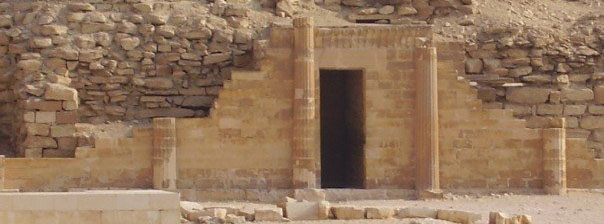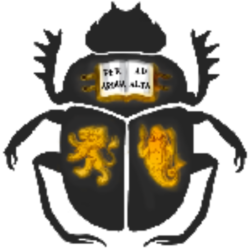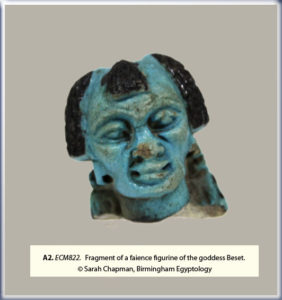Click the images to enlarge
——————————————————————————————————————————————————————————-
A. Object Labels (pdf file)
Click here for a 3D pdf model of A2. ECM822 (pdf file)
 The name ‘Bes’ is in fact a general term applied indiscriminately to a number of lesser known similar dwarf deities dating at least as far back as the Middle Kingdom (Romano 1980: 39). The oldest known of these deities is named Aha, while ‘Bes’ was introduced later during the New Kingdom, followed by others in the Late and Greco-Roman Periods. This exhibition will therefore retain the frequently adopted terminology of ‘Bes-image’ and ‘Bes-deity’ (Romano 1980; Dasen 1993: 57) when discussing the iconographic development of this complex ancient Egyptian god as none of the objects under discussion preserve their original identity.
The name ‘Bes’ is in fact a general term applied indiscriminately to a number of lesser known similar dwarf deities dating at least as far back as the Middle Kingdom (Romano 1980: 39). The oldest known of these deities is named Aha, while ‘Bes’ was introduced later during the New Kingdom, followed by others in the Late and Greco-Roman Periods. This exhibition will therefore retain the frequently adopted terminology of ‘Bes-image’ and ‘Bes-deity’ (Romano 1980; Dasen 1993: 57) when discussing the iconographic development of this complex ancient Egyptian god as none of the objects under discussion preserve their original identity.
Dasen discussed a number of reasons for the multitude of ‘hybrid dwarf gods’ and suggested that the name ‘Bes’ may in fact have been used as early as the Greco-Roman Period as a generic term for many variant deities with the same or similar physical forms (Dasen 1993: 57). This same ‘“families” of divine beings’ possibility has been shown in the case of ‘Taweret’, when a group of up to fourteen hippopotamus goddesses were known to share a single identity (Dasen 1993: 57). This goddess occupies a space similar to ‘Bes’ in the Egyptian pantheon, as a protector of domestic life and can be seen in object 1969W1212.
The roles of these dwarf-like deities lie within domestic contexts and were intended to protect the inhabitants of the households. Therefore, many of the Bes-images found within these environments are most likely apotropaic in nature and were intended as focal points of household religion, or talismanic in their purpose to ward off danger. It is therefore unsurprising to find many gestures on the following objects relating to protection and aggression. The name Aha may actually refer to the god’s role as ‘the fighter’ (Romano 1980: 49) and could relate to his function as an aggressor against evil.
Bes-deities are also frequently shown alongside Taweret in their role as protectors of women during pregnancy and childbirth (1969W1212). This role is emphasised during the Third Intermediate Period with the appearance of Bes-deities in suckling scenes with the mother goddess Beset, as exemplified through ECM822 (Graves 2013: 2). It would currently seem that these deities were usually restricted to the domestic environments of all levels of Egyptian society and only later were given space in temple or funerary contexts. During the Late Period and Greco-Roman Period the popularity of the Bes-image increased once again and examples of the imagery are found all over the eastern Mediterranean in domestic contexts indicating that his role was universally understood (Altenmüller 1973: 720).

The lack of evidence for a major state temple dedicated to a Bes-deity (Zivie-Coche 2011: 7) may imply that they should be viewed as apotropaic demons rather than state deities. This leads to question why there were changes in the iconography of the Bes-image, and to ask what or who stimulated those alterations. To begin answering these questions this exhibition aims to explore a number of iconographic types preserved in the two collections to exemplify these changes and identify their origins.


